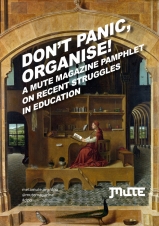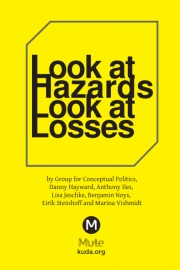On the Creativity of the Creative Industries: Some Reflections
Now that the dust has settled on last November’s MyCreativity conference in Amsterdam, Sebastian Olma returns to the questions it raised over the creative industries, how their commercial conceptions of creativity relate to ‘real’ or ‘authentic’ creativity, and whether their revolutionary potential is anti-capitalist or simply managerial
MYCreativity
Over the last decade or so, the notion of creativity has come to global prominence as an attribute sparking the imagination of neo-liberal elites and providing the respective policy projects (creative cities, creative clusters, creative economies, creative industries, etc.) with a token of sanctity. Of particular interest in this context is the notion of the creative industries (CI) that recently has become something of a new paradigm for policy makers, investors, practitioners and academics alike. Feeling the need ‘to bring trends and tendencies around the Creative Industries into critical question,’ Amsterdam’s Institute for Network Cultures (INC) teamed up with the University of Ulster’s Centre for Media Research for the MyCreativity conference in November 2006.[1] MyCreativity featured designers, activists, critical intellectuals, mainstream academics, art critics, curators and even a self-invited WIPO representative.[2] Its formula for success – and such it doubtlessly was – consisted in bringing together a variety of people who do not usually encounter one another, thus accomplishing a sort of cross-section of the theory and practice of the creative industries.
The present article takes up some of the contributions to and impressions of MyCreativity in order to reflect on questions regarding creativity, the creative industries, and their significance for contemporary capitalism.[3] An instructive starting point for such a reflection is provided by Ned Rossiter, one of the co-organisers of MyCreativity. His book Organized Networks was launched at the Amsterdam event, thus providing a sort of academic blueprint for the conference. Rossiter links the rise of creative industries to the emergence of two policy trajectories. One was initiated by the Blair government’s Department of Culture, Media and Sport’s (DCMS) ‘Task Force Mapping Document’, which decreed a new post-industrial super-sector out of 13 otherwise distinct sectors ranging from advertising, interactive leisure software to performing arts. The policy initiative around this document is seen by most CI-researchers as the birth of the creative industries as we know them today. The other trajectory takes off from the 1995 WTO Agreement on Trade-Related Aspects of Intellectual Property Rights (TRIPS), which inaugurated the juridical regime of control over the increasing informatisation of social relations.
This double foundation of CI policy makes clear that what is at stake in the global rise of the creative industries paradigm is more than simply the export of Blairite ideology. As the DCMS put it, the central goal of its initiative is ‘the generation and exploitation of intellectual property.’[4] In other words, CI policy aims at a transformation of the structural conditions of production in such a way that ‘creativity’ (the reference here is to ‘individual creativity, skill and talent’) can be channelled into regimes of property. However, as Rossiter stresses, in order to address the political dimension of CI, the ‘structural determination’ resulting from these policy interventions has to be understood in combination with ‘the conditions and experience of creative labour as it relates to intellectual property regimes.’[5]
Focusing on policy reports alone does not get one very far in understanding the complexity of creative industries. Fortunately just a few presentations at MyCreativity adopted this type of approach. Often combined with a super-reductive notion of Foucauldian discourse analysis, all that this type of research accomplishes is the transformation of critical analysis into an exercise in recording statements found in policy reports, governmental websites and the like.
A different understanding of ‘structural determination’ was suggested by Brian Holmes’ brilliant analysis of North Carolina’s Research Triangle Park. Holmes essentially depicted CI practice as an exercise in intensified cluster building for the sake of generating industry-compatible creativity. As he argued, science parks of this kind can be seen as conveyor belts between universities and industry, accelerating the transformation of the former into production sites of copyrightable and patentable knowledge. Here, creativity is fed into a program of corporatisation, flexibilisation, and militarisation. Anthony Davies’ presentation in a certain sense extended Holmes’ analysis by exploring the ongoing transformation of British universities into globally operating businesses.
Another structure determining creativity and its appropriation is of course the city. At MyCreativity the most interesting ‘dispatches from the city’ were presented by a number of activists/autonomous researchers. Drawing on the work of David Harvey as well as on his own research, Matteo Pasquinelli described Barcelona’s ascent to prominence within the system of European cities as being based on an economy of rent. According to Pasquinelli, Barcelona’s success can in no small part be attributed to the ‘collective hallucination’ of a creative city based on the steady accumulation of symbolic capital. This collective hallucination can be appropriated economically as it creates a sort of cultural monopoly for Barcelona translating into exploding real estate and housing prices. Merijn Oudenampsen presented a carefully constructed map of Amsterdam’s ‘extreme makeover,’ dissecting the seemingly consensual and balanced but in reality rather brutal reinvention of the city as an archipelago of creative islands, featuring – among other things – the open racism toward its Turkish and North African population for which the Netherlands have become notorious over the last few years.
A very engaging report from Berlin was delivered by Sebastian Luetgert who tried to understand the current attraction of Berlin as a result of the city’s permanent economic (fiscal) crisis. Berlin is essentially a city of failure. As Luetgert argued, it is such a condition of structural precarity that provides a fertile soil for appropriable social creativity. As Berlin’s mayor puts it: ‘Berlin is poor but sexy.’ What these ‘city reporters’ agreed on was that Richard Florida’s ‘creative class’ is – if anything – ‘a parasitic simulacrum of social creativity’ (Pasquinelli). The question then becomes how one actually determines real or authentic social creativity, if it exists at all.
Since the publication of Empire, post-Autonomist thought has become highly influential as a version of Marxism that rejects the dialectic in favour of an analysis of indeed the real or authentic forces of creativity, conceptualising the latter in terms of the ontological primacy of puissance, potentia, Vermögen: a pre-individual, generically social power articulated in the dynamic historical subjectivity of the multitude. It is therefore not surprising that the question of creativity was most explicitly raised at MyCreativity by contributions from this intellectual tradition. Christoph Spehr for instance argued for a displacement of the analytic perspective of CI-research from focussing on the creative industries per se to thinking creativity within the broader context of a shift in the capitalist mode of production. Recalling the social factory thesis developed by Mario Tronti in the early ’70s , Spehr noted how the Fordist regime of production pulled the social into the factory, whereas post-Fordism distributes production throughout the entire social field. Similarly, Pasquinelli reproached critical CI research for having failed to develop a proper understanding of what constitutes creativity in contemporary capitalism. He insisted on a ‘Copernican turn’ that needs to take place, shifting attention ‘to autonomous labour and autonomous production.’ In other words, in order to understand CI as a particular practice in the context of contemporary capitalism it might be instructive to analyse the living forces on which the entire capitalist machine runs.
POST-AUTONOMIA AND CREATIVITY
If, on the one hand, post-Autonomous thought represents a systematic attempt at grasping creativity while, on the other hand, the creative industries are a method of exploiting creativity, then the former should offer a potentially rich perspective for the exploration of the latter. Thus, before returning to an explicit discussion of the CI issue, a brief look at some post-Autonomist approaches to creativity in contemporary capitalism is on order.
In Empire Antonio Negri and Michael Hardt understand real creativity as something inherent to what they call the ‘social bios,’ i.e., the living multiplicity that constitutes the social.[6] Under contemporary conditions of real subsumption, social bios is held in a state of permanent virtual mobilisation by novel dispositifs of capital – such as, indeed, IP – that capture the increasingly immaterial labour of the informational economy. Immaterial labour in its info-industrial, symbolic, analytic and affective aspects is seen by the authors as a more authentic, autonomous expression of ‘social bios’ than, say, industrial labour, since social interaction and cooperation are immanent to immaterial labour rather than being the result of capital’s imposition. For Hardt and Negri, this signals a becoming ontological of exploitation: the poietic potential of ‘social bios’ is rendered effective in immaterial labour while the passage toward a creative praxis (in the Marxian sense of human being’s capacity to constitute their genus in praxis) is perpetually blocked. Social life is in a state of permanent mobilisation but without the possibility of adequate actualisation. The immanent creative expression of the multitude is encouraged by the dispositifs of neoliberal capitalism as long as it remains outside the sphere of the political. What initially appears to be real creativity (praxis) on closer inspection turns out to be its perpetual postponement for the sake of capitalist poiesis. It takes Negri’s particular Spinozian magic to appreciate this situation as a revolution taking place [rivoluzione avvenuta] that merely needs to be realised.[7]
A bit more ambivalent on the question of creativity and revolution is Paolo Virno, whose notion of virtuosity highlights capital’s subsumption of two central aspects of praxis: on the one hand, virtuosity characterises an action that finds its purpose and fulfilment within itself. The virtuoso’s product is her performance. On the other hand, it marks the intrinsically social dimension of contemporary labour. Virtuosity implies the presence of others, an audience or witness on which the virtuoso has to rely in the absence of a material end-product of her performance. Not unlike politics, virtuosity requires a ‘publicly organised space’. Such a strange ‘politicisation’ of production is not something that happens arbitrarily. According to Virno, centuries of modern capitalism have transformed the contemporary multitude into a bios xenikos, i.e., a living multiplicity of strangers. He refers to the condition of ‘not feeling at home’ as the permanent and irreversible situation of the contemporary multitude.[8] It is in fact this ontological lack of home, he argues, that leads to the attempted escape of the multitude into the ‘apotropaic’ resources of language and co-operation, to speaking and sharing as generic capacities of the species. Virno’s perhaps romantic reference to an ontological lack of home would thus suggest a field of practice such as the creative industries to be a sort of pseudo-shelter drawing the multitude’s capacity to constitute itself as an open genus into a productive custody that is simultaneously a political black hole for Negri’s rivoluzione avvenuta.
Finally, Maurizio Lazzarato understands creativity (he also refers to invention) in terms of an event that emerges as an expression of a ‘possible world’ in order to then become actualised in corporeal practice.[9] Such a ‘creation of worlds’ defines Lazzarato’s understanding of the political which is modelled on the emergent forms of post-socialist movements whose logic is that of the networked invention of new forms of social life rather than class struggle. Only such a perpetual exodus from existing forms of sociation (a sort of super-reflexive line of flight) has a chance of bringing about the adequate social articulation of the ontological puissances de l’invention, that is, real creativity.[10] The virtual source of ontologically adequate creativity Lazzarato refers to as ‘inter-cerebral cooperation.’ Contemporary capitalist production does of course tap this source but rather than allowing its proper expression, the puissances are transformed into pseudo-events or pseudo-worlds. Practices such as those taking place within the creative industries are understood as being productive of assemblages of expression that effectuate pseudo-worlds, i.e., corporately induced lifeworlds in need of specific products. Tools such as intellectual property and copyright are indispensable as they insert an artificial border through an otherwise immanent multiplicity of ‘inter-cerebral cooperation’. Common goods that naturally evade the logic of capitalist valorisation because they escape the logic of scarcity (knowledge, language, art, science, etc.) can thus be subsumed under the axiomatics of capital. However, within the capital relation, creative activity must always be reduced to productive labour, i.e., an institution that destroys creativity or reduces it to the simulated creativity of capitalist poiesis. Hence, and here Lazzarato entertains an interesting relation to Virno, the paradox of contemporary capitalism is its reliance on something that is at once its foremost casualty: virtuosity, or, as Lazzarato calls it, social ‘genius.’
CREATIVITY, 'CREATIVE LABOUR', ORGANISATION
Post-Autonomist theory thus allows us to recognise contemporary capitalism as a formidable force of anti-production with dispositifs such as the creative industries being in fact great destroyers of real (i.e., ontologically adequate) creativity. They are feverish attempts to plug into new sources of value that – although formally successful (the creative industries do generate profits) – remain inadequate with respect to the enormous potential inherent to the materiality of contemporary social life. The creative industries represent a particularly cunning dispositif in this context as they also represent an active intervention into the machine of expression in so far as they try to discursively confine creativity to a specific field of capitalist practice. Inserting post-Autonomist thought into CI-debates might help to counteract this tendency.
Rossiter’s work on the creative industries is an attempt to critically draw on this tradition in order to make sense of CI-practice. His analysis is predicated on the notion that what he calls ‘creative labour’ forms the constitutive outside of the creative industries. Now, this might sound trivial but in fact it is not. What Rossiter argues is not merely that CI-research has to take into account ‘the conditions and experience of creative labour’ but rather that ‘creative labour’ provides a possible basis for an immanent and practical form of critique:
In the case of the creative industries, the constitutive outside is a force of relations characterized by two key features: antagonism in the form of the exploitation of creative labour as it subsists within a juridico-political architecture of intellectual property regimes; and the affirmation of creative labour that holds the potential for self-organization in the form of networks.[11]
Rossiter here points to the political potential of ‘creative labour’ that he locates at the level of organisation. In order to appreciate this argument one needs to specify the post-autonomist argument about capitalism’s ontological turn in terms of its organisational articulation. Neoliberalism’s systematic disorganisation of production, Rossiter argues, also represented a departure from the transcendent rigidity of modern organisation. It is well known that Gilles Deleuze conceptualised such a change in organisational strategy in terms of a shift from moulding to modulation: what was previously arrested in the moulds of confinement is now allowed to flow within the channels of more topological or process-like arrangements.[12] Instead of pre-emptively imposing a metric pattern of moulds on the creative forces, the neoliberal organisation of labour prefers modes of control that are able to flexibly modulate the creative process per se. As Foucault has shown in La Naissance de la Biopolitique the logic of neoliberalism is to act not directly on but around the creative process of living labour.[13] Hence, neoliberalism’s demand of super-human flexibility and dynamism, its reinvention of living labour in terms of a perpetually self-improving ‘human capital’ necessitates a structural opening that capital cannot fully control.
With particular reference to the creative industries, Rossiter defines ‘creative labour’ in terms of being ‘disorganised’ in order to foreground its political potential: here, he argues, the neoliberal disorganisation of production is predicated on an emerging network ecology that entails the potential for the self-organisation of ‘creative labour’. It cannot be denied that there are self-organising groups of creative workers – such the French Intermittents – that use network ecologies as their mode of organisation. However, if one moves up the network a bit, say to the level of the EuroMayDay networks, one realises that the practice of organised networks is by no means a privilege of so called ‘creative labour.’ This is not to dismiss Rossiter’s argument at all. To the contrary, his analysis is absolutely crucial as it points toward political trajectories that are opening up as capital adjusts to the evolving materiality of social life. What would be problematic is the reductive totalisation (or, in Marxist lingo, fetishisation) of these new forms of labour that understands ‘creative labour’ in terms of a political vanguard.[14]
Rossiter is clearly aware of this problem, which might have been one of the reasons for inviting Valery Alzaga from Justice for Janitors to MyCreativity. Her powerful political message was a reminder to the assembled ‘creative workers’ that any consequent attempt to understand the creative network of living labour under conditions of neoliberalism must include those armies of workers whose activities would not so easily receive the label ‘creative’. Looking at neoliberal, disorganised capitalism it is paramount to realise that its economic network ecologies are themselves constituted by those creative networks that the post-Autonomists approach in terms of social bios, virtuosity, intercerebral cooperation and so on. These creative networks not only extend throughout the entire social field, they are also ontologically prior to any division that capital might insert into it.
The crucial argument to be put forward with respect to the creative industries is that they are indeed the product of such an insertion. This is to say that the proliferation of economies of intensified creativity and invention cannot be conceptualised without reference to the simultaneous expansion of a new kind of economies of intensified repetition. The latter takes the form of a network of generic labour among which feature the aforementioned janitors. Today, such generic labour has become a massive phenomenon. One of its genealogical sources can be found in the post-war practice of corporations to vertically disintegrate (a trend arriving in Europe and the US via-Japanese automobile manufacturers), i.e., to outsource their supply chain. In the late 1980s the practice of outsourcing began to invade the organisation structure per se. What began with janitors and technical staff soon reached those repetitive administrative processes that until recently were considered to be integral part of any given organisation: information technology, accounting, financial services, payroll, human resources, customer relations, etc. The massive growth of these kinds of outsourcing has resulted in the emergence of an archipelago of neo-factories of concentrated organisational routine hidden in the periphery of an ostensibly creative economy. There is now a wide network of intensively repetitive labour that almost invisibly sustains the ‘liberated’ organisational arrangements within which capitalism’s contemporary pseudo-creativity can thrive.
Developing a proper understanding of the interface between economies of difference and economies of repetition (the latter of which includes intensified industrial production) will require a good deal of research. However, it does appear reasonable to assume that in order to make sense politically of creativity under conditions of contemporary capitalism, these two economies need to be conceptually brought together. Nigel Thrift describes neoliberal network ecology as a situation in which, ‘more and more companies are becoming like project co-ordinators, outsourcing the “business-as-usual” parts of their operations so that they can be left free to design and orchestrate new ideas.’[15] Today the generation of these new ideas and ‘immaterial’ goods is increasingly outsourced to the ‘liberated’ spaces in which ‘creative labour’ dwells (unless it is ‘crowdsourced’ to potential consumers). Perhaps it would be apposite to speak of a new division of labour along the lines of difference and repetition, held together by the mediation of Thrift’s project-coordinators.
Whatever is created within the arbitrarily defined context of the creative industries is the result of a creative social process that cannot be reduced to an internal affair of ‘creative labour’. If there is anything to be learned from a post-Autonomous approach to contemporary capitalism, it is that creativity does not belong to an actual social group but rather is an immanent property of a social multiplicity that precedes the structures of exploitation. Neoliberal capitalism’s division and intensification of economies of difference and economies of repetition should not make us forget the Deleuzean (originally Tardian) insight that creativity includes both, difference and repetition. In the context of neoliberal capitalism in general and the creative industries in particular, it might be an insight whose repetition will make an important analytical difference.
[1] MyCreativity: Convention of International Creative Industries Researchers, Centre for Media Research, University of Ulster and the Institute of Network Cultures, Amsterdam, 16-18 November, 2006, http://www.networkcultures.org/MyCreativity/
[2] World Intellectual Property Organization, http://www.wipo.int
[3] For a more general review of MyCreativity see Monika Mokre, http://transform.eipcp.net/correspondence/1166104888
[4] Ned Rossiter, Organized Networks: Media Theory, Creative Labour, New Institutions, Rotterdam: NAi Publishers, 2006, p. 26.
[5] Richard L. Florida, The Rise of the Creative Class: And How It’s Transforming Work, Leisure, Community and Everyday Life, New York, Basic Books, 2002.
[6] Antonio Negri, Subversive Spinoza: (Un)Contemporary Variations, trans. T. Murphy, Manchester University Press, Manchester, 2004.
[7] Michael Hardt and Antonio Negri, Empire, Harvard University Press, Cambridge, Mass. 2000.
[8] Paolo Virno, A Grammar of the Multitude: For an Analysis of Contemporary Forms of Life, trans. J. C. I. Bertoletti and A. Casson, Semiotext(e), Los Angeles, 2004, p. 38.
[9] Maurizio Lazzarato, Les Révolutions du Capitalisme, Les Empêcheurs de Penser en Rond, Paris, 2004.
[10] Maurizio Lazzarato, Puissances de l'Invention : La Psychologie Économique de Gabriel Tarde contre l'Économie Politique, Les Empêcheurs de Penser en Rond, Paris, 2002.
[11] Rossiter, op. cit. p. 32.
[12] Gilles Deleuze, Negotiations, 1972-1990, Columbia University Press, New York, 1995.
[13] Michel Foucault, La Naissance de la Biopolitique. Cours au Collège de France 1978-1979, Gallimard/Seuil, Paris, 2004.
[14] Steve Wright, Storming Heaven: Class Composition and Struggle in Italian Autonomist Marxism, Pluto Press, London, 2002.
[15] Nigel Thrift, 'Re-Inventing Invention: New Tendencies in Capitalist Commodification,' Economy and Society 35(2), 2006, p287.
Mute Books Orders
For Mute Books distribution contact Anagram Books
contact@anagrambooks.com
For online purchases visit anagrambooks.com






